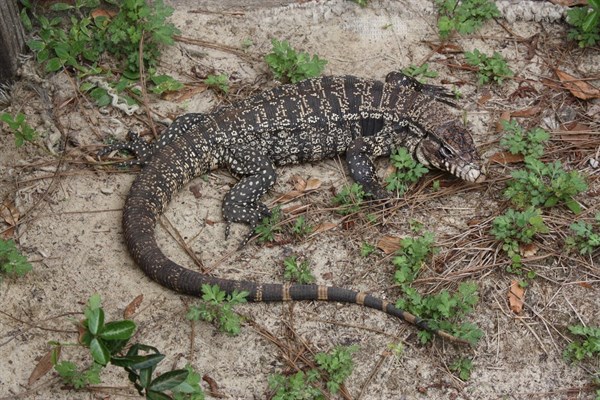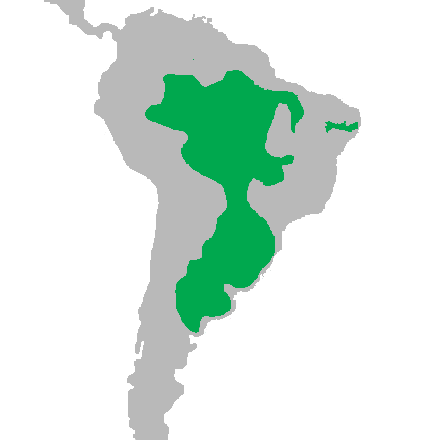Invasive Species of the Reptilian Kind

The Argentine Black and White Tegu (Salvator merianae) is a large South American lizard not native to the U.S. (Stan Kirkland/Florida FWC)

The Argentine Black and White Tegu is native to Brazil, Paraguay, eastern Uruguay and northern Argentina. Source: Florida Fish and Wildlife Conservation Commission
Tegu is a common name of a number of species of lizards that belong to the families Teiidae and Gymnophthalmidae. Tegus are native to Central and South America. They occupy a variety of habitats and are known for their large size and predatory habits. Wikipedia
Introduction of non-native species that can thrive under the existing or altered range of environmental variation can contribute to the extinction of native species, severely modify food webs, and alter ecological processes such as nutrient cycling. invasive species are often successful in modified systems, where they can be difficult to eradicate.
As an analogy, bureaucrats, and politicians seldom project far enough into the future to fully account for the potential costs of their short-term plans allowing invasive predatory populations to cross our natural boundaries.
Argentine Black and White Tegus: Invasive Lizards Threaten Native Georgia Wildlife
DNR and partners are working to eradicate a wild population of Argentine black and white tegus in Toombs and Tattnall counties in southeast Georgia.
Growing up to 4 feet long and weighing 10 pounds or more, this lizard native to South America is an invasive species that threatens Georgia wildlife.
Tegus will eat the eggs of ground-nesting birds—including quail and turkeys—and other reptiles, such as American alligators and gopher tortoises, both protected species. They will also eat chicken eggs, fruit, vegetables, plants, pet food, carrion and small live animals, from grasshoppers to young gopher tortoises.
Early detection, rapid response and public involvement are key to stopping tegus in this area.
In Toombs and Tattnall, DNR’s Wildlife Resources Division, the U.S. Geological Survey and Georgia Southern University are trapping tegus, tracking sightings and assessing the population.
What You Can Do
Tell DNR when you see a tegu in the wild, alive or dead. These reports help biologists document occurrences and respond effectively. Note the location, take a photo if possible and report the sighting:
→ Online: www.gainvasives.org/tegus
→ Phone: (478) 994-1438
→ Email: gainvasives@dnr.ga.gov
In Toombs and Tattnall counties, keep pet food inside, fill holes that might serve as shelter and clear yards of debris such as brush piles that can provide cover for tegus.
Be a responsible pet owner. Do your research before buying an exotic pet, and don’t let it loose.
Note that as a non-native species, tegus in the wild in Georgia are not protected by state wildlife laws or regulations. They can be legally trapped or killed. However, animal cruelty and local ordinances apply, as do appropriate safety precautions.
Tegus at a Glance
♦ The Argentine black and white tegu (Salvator merianae), largest of all tegu species, is native to Brazil, Paraguay, Uruguay and Argentina.
♦ Black to dark gray with white speckled bands across the back and tail, these reptiles can weigh 10 pounds or more and live 20 years. Hatchlings have bright green on their heads, a coloration that fades at about 1 month old.
♦ Sizes vary by age. Hatchlings can be about 6-8 inches long. Adults documented in the wild in Georgia have averaged slightly less than 2 feet.
♦ Tegus are active by day. These fast-moving, terrestrial lizards are rarely found more than a few feet off the ground. But they are strong swimmers and can stay submerged for extended periods.
♦ Tegus occupy mixed grassland/woodlands and disturbed habitats such as forest clearings, fence rows and roadsides. They winter in burrows or under cover in a hibernation-like state called brumation. In Argentina, tegus are found from sea level up to altitudes of 4,100 feet.
♦ Adult tegus have few predators and can multiply quickly. Females reach reproductive age at about 12 inches long or after their second season of brumation. They can lay about 35 eggs a year. Hatching in Georgia would be expected in June/July.
♦ Tegus are legal as pets in Georgia but it is illegal to release non-native animals into the wild.
♦ Although not considered aggressive toward people, tegus will defend themselves if threatened. They can react fast and lash with their tails. They have sharp teeth and claws and strong jaws.
♦ In Georgia, tegus might be confused with native reptiles such as juvenile alligators (which are protected), broadhead skinks and eastern fence lizards (although even as adults, all native lizards would be no larger than a hatchling tegu).
Resources
→ Argentine black and white tegus in Florida
Sources include: Florida Fish and Wildlife Conservation Commission
Why are tegus a concern in Georgia?
Tegus are not native to our state and have been known to eat native species including the eggs of alligators and threatened wildlife, such as hatchling gopher tortoises. Tegus may be more cold tolerant than other reptile species and more likely to spread throughout the state. There are also concerns these reptiles could cause bacterial contamination of crops and spread exotic parasites to native wildlife.
Georgia’s State Wildlife Action Plan emphasizes that invasive species are a significant problem for native animals and plants. Invasives compete with native wildlife for food and other resources. They can cause habitat damage and transmit diseases and parasites. In many cases, they also prey on native wildlife. The Wildlife Action Plan is a comprehensive strategy for conserving wildlife and their habitats statewide.
How widespread are tegus in Georgia?
Georgia’s only known wild population is in Toombs and Tattnall counties. In 2018, DNR’s Wildlife Resources Division, working with DNR Law Enforcement, began investigating reports of Argentine black and white tegus in eastern Toombs and western Tattnall.
How did they get here?
DNR cannot say definitively but it is likely the tegus in Toombs and Tattnall originated with captive animals that either escaped or were released.
Are tegus a threat to pets?
While tegus are omnivores and eat a variety of plant and animal matter, they are not considered a threat to pet dogs and cats. Florida’s wildlife agency—which has been dealing with tegus much longer than Georgia DNR—is not aware of any predatory attacks on pets in that state. However, DNR advises against leaving pet food outdoors: It can attract tegus and other wildlife to your yard.
Could tegus spread to other parts of Georgia?
Tegus can brumate (reptile hibernation) during colder months, increasing their likelihood for survival across the state. There is scientific evidence suggesting tegus could spread even to other parts of the southeastern U.S. In Florida, tegus have established three wild populations and are considered a high-priority exotic, invasive animal targeted for removal from the wild.
What is being done to deal with tegus in Toombs and Tattnall, or elsewhere in the state?
DNR is working with the U.S. Geological Society and Georgia Southern University to trap tegus in Toombs and Tattnall, removing animals and assessing the population. Trapped tegus are humanely euthanized and their diet and reproductive status are documented. Also, public outreach is raising awareness of the threat tegus pose and the need to report them.
Elsewhere in the state, DNR is responding to any reported sightings. Rapid response is key to combating the establishment and spread of tegus and other exotic invasive species.
Can tegus be owned as pets?
Tegus are legal in Georgia to own as pets and they are popular in the pet trade. But it is illegal to release any non-native animal into the wild without a permit.
Can I kill a tegu if I see it in the wild?
Yes. Tegus are not native to Georgia and as a non-native species they can be killed on private property with the landowner’s permission and using legal methods in accordance with local ordinances, animal cruelty laws and safety precautions.
In the Toombs-Tattnall area, will DNR or its partners remove a tegu from my property?
DNR is working with the USGS and Georgia Southern to remove tegus from the wild in the area and will respond to confirmed sightings in the area if possible.
Source: https://georgiawildlife.com/tegus
Accessed 16 May 2020
Florida Fish and Wildlife Conservation Commission – Argentine black and white tegu
Florida Distribution
Reproducing populations of Argentine black and white tegus are established in Hillsborough and Miami-Dade Counties. An emerging population was recently discovered in Charlotte County after several confirmed reports were received through the Florida Fish and Wildlife Conservation Commission (FWC) Exotic Species Hotline. Researchers believe these populations occurred through escapes or intentional pet releases. Argentine black and white tegus have also been reported from other Florida counties, though these observations are most likely isolated occasions of escaped or released pets and not related to successful breeding populations. Some limited observations of red tegus (Salvator rufescens) and gold tegus (Tupinambis teguixin) have also been recorded in Florida.
Potential Impacts
Potential impacts of tegus include competition with and preying upon Florida’s native wildlife, including some imperiled and protected species. Tegus prey upon the nests of other animals, and researchers have documented tegus eating American alligator eggs and disturbing American crocodile nests in Florida. Recent gut content analysis of tegus by the FWC revealed that they consume threatened juvenile gopher tortoises and agriculturally valuable foods, thus highlighting the impact this species may have on sensitive wildlife and agricultural lands. Though current population estimates are not available for this species, evidence suggests possible expansion of their populations. Adults have few predators and can give birth to large numbers of offspring per year, increasing the risk of populations spreading beyond their established counties and impacting surrounding areas.
Regulatory Status
The State of Florida lists tegus as Class III wildlife. A permit is not currently required to possess tegus as personal pets, but the state does require a License to Possess Class III Wildlife for Exhibition and/or Public Sale to possess these reptiles for commercial use and a Captive Wildlife Importation Permit to import them into the state.
More Information
University of Florida-Florida’s lizards-Nonnative Tegu Lizards
ECISMA information on Argentine black and white tegus
References
Abe, A. S. (1995). Estivation in South American amphibians and reptiles. Brazilian journal of medical and biological research= Revista brasileira de pesquisas medicas e biologicas 28(11-12):1241-1247.
Donadio, O. E., & Gallardo, J. M. (1984). Biología y conservación de las especies del género Tupinambis (Squamata, Sauria, Teiidae) en la República Argentina. Revista del Museo Argentino de Ciencias Naturales “Bernardino Rivadavia” Zoologia 13:117-127.
Fitzgerald, L. A., Cruz, F. B., & Perotti, G. (1993). The reproductive cycle and the size at maturity of Tupinambis rufescens (Sauria: Teiidae) in the dry Chaco of Argentina. Journal of Herpetology 27(1):70-78.
Giardina, D., and Pernas, T. (2011). Argentine Black and White Tegu Assessment in South Florida [PowerPoint slides]. Retrieved from ECISMA Summit:http://bugwoodcloud.org/mura/ECISMA/assets/File/summit11/6_ECISMA_Pernas_Tegu-2011.pdf.
Johnson, F. A., Smith, B. J., Bonneau, M., Martin, J., Romagosa, C., Mazzotti, F., & Vitt, L. J. (2017). Expert Elicitation, Uncertainty, and the Value of Information in Controlling Invasive Species. Ecological Economics 137:83-90.
Martuscelli, P., & Olmos, F. (1996). Tupinambis teguixin (common tegu): foraging. Herpetol Rev. 27:1-21.
Mazzotti, F. J., McEachern, M., Rochford, M., Reed, R. N., Eckles, J. K., Vinci, J., & Wasilewski, J. (2015). Tupinambis merianae as nest predators of crocodilians and turtles in Florida, USA. Biological Invasions 17(1):47-50.
Pernas, T. and Giardina, D. (2011). Argentine Black and White Tegu Assessment in South Florida. ECISMA Summit.
Pernas, T., Giardina, D. J., McKinley, A., Parns, A., & Mazzotti, F. J. (2012). First observations of nesting by the Argentine black and white tegu, Tupinambis merianae, in south Florida. Southeastern Naturalist 11(4):765-770.
Presch, W. (1973). A review of the tegus, lizard genus Tupinambis (Sauria: Teiidae) from South America. Copeia 1973(4):740-746.
Yanosky, A. A., & Mercolli, C. (1992). Tegu lizard (Tupinambis teguixin) management in captivity at El Bagual Ecological Reserve, Argentina. Arch. Zootec. 41(151):41-51.
Source: Florida Fish and Wildlife Conservation Commission
Accessed 16 May 2020